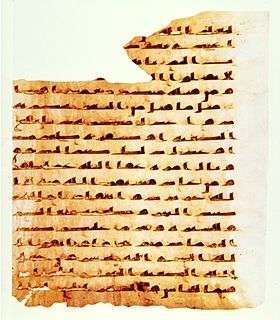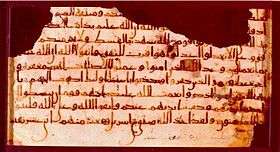Beit Al Quran
| بيت القرآن | |
| Established | 1990 |
|---|---|
| Location | Hoora, Manama, Bahrain |
| Type | Islamic museum |
| Collection size | 10,000 books and manuscripts |
| Director | Samar al Gailani[1] |
| Website | Official website |
Beit Al Qur'an (Arabic: بيت القرآن, meaning: the House of Qur'an) is a multi-purpose complex dedicated to the Islamic arts and is located in Hoora, Bahrain.[2] Established in 1990, the complex is most famous for its Islamic museum, which has been acknowledged as being one of the most renowned Islamic museums in the world.[3]
Establishment

Construction of the complex began in 1984 and the museum was officially opened in March 1990 by Abdul Latif Jassim Kanoo. It was built to "accommodate a comprehensive and valuable collection of the Qur'an and other rare manuscripts", a concept which, according to a regional magazine, is unique in the Persian Gulf region.[4] The core of the museum's holdings is Kanoo's own collection of Qur'anic manuscripts and Islamic art, since he was reportedly said to have been an avid collector. As his collection grew, he reportedly came to feel a strong sense of responsibility toward the rare manuscripts he had acquired. In 1990, he donated his collection to the museum he established to operate a first-of-its-kind institution dedicated to the service of the Qur'an and the preservation of historic manuscripts.[3]
The establishment of the institute was funded completely by public donations, with added help from a variety of people from all walks of life in Bahrain, ranging from heads of state to school children. The facilities at Beit Al Qur'an are free to the general public.[5]
The institution and its museum house an internationally celebrated collection of historic Quranic manuscripts from various parts of the Islamic world, from China in the East and to Spain in the West, representing a progression of calligraphic traditions from the first Hijri century (622–722 AD) and of the Islamic Golden Age, to the present day.[6][7]
Facilities
| Quran |
|---|
 |
|
The Beit al Qur'an complex is open to the public on Saturdays to Wednesdays from 9am to 12pm and 4pm to 6pm respectively.[8] The complex's exterior designs are based on an old fashioned 12th-century mosque.[7] The entire complex itself comprises a mosque, a library, an auditorium, a madrasa, and a museum that consists of ten exhibition halls. A large stained glass dome covers the grand hall and mosque. The Mihrab, the sign indicating the direction to Mecca, is covered in blue ceramic tiles with engraved Al Qursi Qur'anic verse.[9]
The library consists of over 50,000 books and manuscripts in three languages – Arabic, English and French – that are mostly on Islam. The institute does specialise in Islamic art, and many of the reference books have international importance. The library and its reading rooms are open to the public during working hours with internet access available, as well as providing individual rooms for researchers and specialists.[7]
There is also an auditorium – named the Mohammed Bin Khalifa Bin Salman Al Khalifa Lecture Hall – which can accommodate up to 150 people, and is mainly used for lectures and conferences. Guest speakers are brought to Bahrain from many countries, including the US, UK, and France. The conference hall is often made available for general use for public lectures in cooperation with different societies and institutions in Bahrain.[9]
The Yousuf Bin Ahmad Kanoo School for Qur'anic Studies is located within the site. The school offers seven study areas fully equipped with computers and modern aids, with separate classes for women and children learning the Qur'an.[9]
Museum
The Al Hayat Museum is the complex's most recognized establishments; it consists of ten halls spread over two floors, exhibiting rare Qur'anic manuscripts from different periods, starting from the first century Hijra (700 AD). Manuscripts on parchments that originate from Saudi Arabia (Mecca and Medina), Damascus and Baghdad, are present in the museum.[7] The manuscripts undergo special procedures for the preservation of these artifacts, in order to protect them from damages. Some of the artifacts present in the museum include a rare manuscript of the Qur'an, dating to 1694 AD and was printed in Germany. The museum also houses the world's oldest translated copy of the Qur'an, which was translated to Latin in Switzerland and dates to 955 AD.[7] The first copy of the Qur'an, written during the reign of Caliph Uthman ibn Affan, is on display in the museum alongside a number of small copies of the Qur'an, which could only be read using optical instruments.[7]
Grains, peas and rice, dating from the 14th century in present-day Pakistan, which contain surahs engraved into them, are displayed in the museum.[7] The exhibits include a rare number of gold and copper pottery and glass from different eras of Iraq, Turkey, Iran and Egypt, respectively.[7]
The works of Islamic scholars, such as Ibn Taymiyyah are preserved in the museum. It has been claimed to have been "the only institute in the world dedicated to the Qur'an and Qur'anic studies".[10]
See also
References
- ↑ "People in the field of Islamic manuscripts.". The Islamic Manuscript Association. Retrieved 5 October 2012.
- ↑ The Middle East, Volume 1. Greenwood Publishing Group. 2004. p. 6. ISBN 9780313329234.
- 1 2 Nawwab, Ni'Mah Isma'il (May–June 2000). "Beit Al Qur'an Religion, Art, Scholarship". Saudi Aramco World. 51 (3). Retrieved 5 October 2012.
- ↑ "Beit Al Qur'an". TimeOut Bahrain. August 2009. Retrieved 5 October 2012.
- ↑ "Beit al-Quran in Manama, Bahrain". Lonely Planet. Retrieved 5 October 2012.
- ↑ Muqueem Khan, Shaista (November 2008). "Islamic Manuscripts" (PDF). World Congress of Muslim Librarian & Information Scientists. pp. 10, 11. Retrieved 17 October 2012.
- 1 2 3 4 5 6 7 8 "بيت القرآن يستأنف فعالياته غداً السبت الاول من سبتمبر". Bahrain News Agency. Retrieved 4 November 2012.
- ↑ "Bait al Quran". Ministry of Culture (Bahrain). Retrieved 25 June 2013.
- 1 2 3 "Beit Al Qur'an in Bahrain". TimeOut Bahrain. Retrieved 5 October 2012.
- ↑ "Arabic Textbook" (PDF). Yale University Press. Retrieved 17 October 2012.
Coordinates: 26°14′23″N 50°35′30″E / 26.23972°N 50.59167°E

